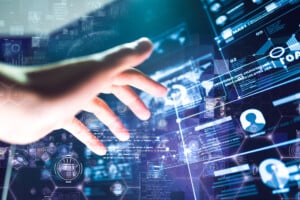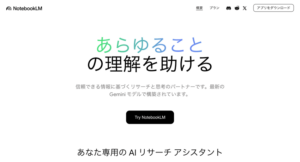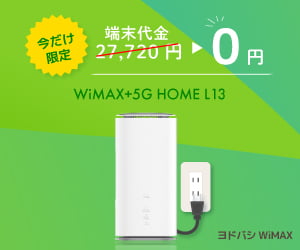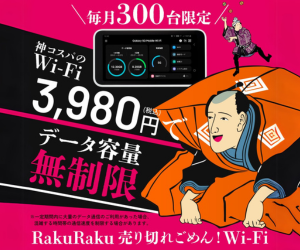Google Mixboard: Visualize Ideas Fast with Nano Banana
【この記事にはPRを含む場合があります】
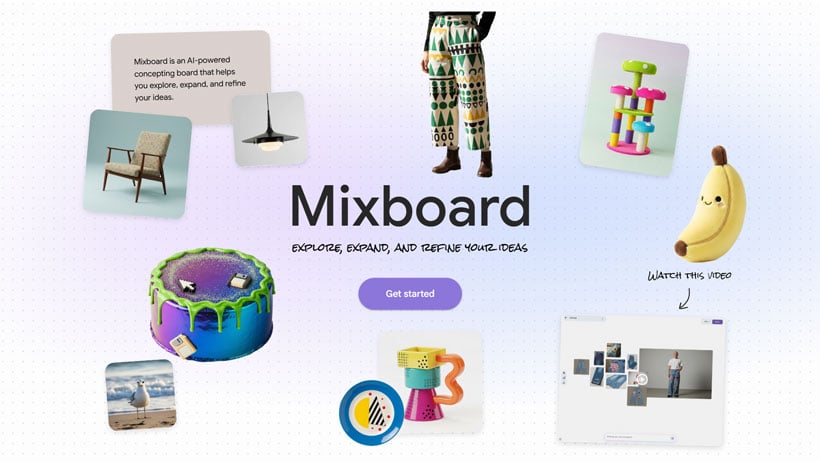
Are you struggling with the time it takes to visualize your ideas? Creating mood boards or proposal materials often means spending hours searching for images or moving inefficiently between multiple tools.
What if AI could instantly generate a large volume of specific visuals based on your vague concepts? And what if you could combine those visuals to forge completely new designs? This revolutionary tool is a game-changer for anyone needing to communicate a visual idea, accelerate brainstorming in the early planning stages, or refine creative concepts.
That tool is the AI concept board “Google Mixboard“, an experimental project from Google Labs. Using this tool not only speeds up design and presentation material creation but also significantly broadens your creative scope. In this article, I will introduce Mixboard’s core mechanics, the role of the notable Nano Banana technology, and my own exciting hands-on experience with its unique capabilities.
- What is Google Mixboard? AI Canvas for Visualizing Ideas
- Cost, Comparison: How Mixboard Differs from Gemini, ChatGPT, and DALL-E 3
- Hands-On Review and How-To: Unlocking Creativity with Mixboard
- Honest Feedback: Mixboard's Strengths and Areas for Improvement
- Accelerating Design and Ideas: The Future Mixboard Brings
What is Google Mixboard? AI Canvas for Visualizing Ideas
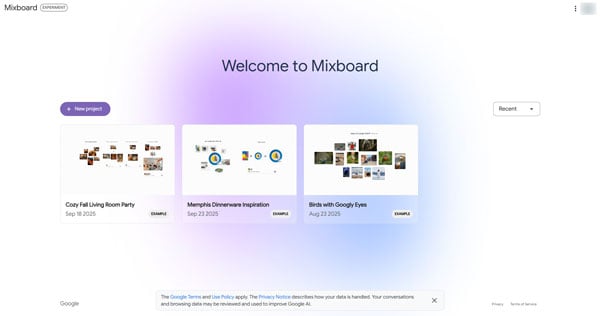
(Source: Google)
Google Mixboard is an experimental, AI-powered concepting board developed by Google Labs. Unlike traditional tools like Pinterest or Canva, which are often used for creating collages, Mixboard integrates AI generation from the start to help users “explore, expand, and refine their ideas”.
Mixboard uses the format of an infinite canvas (whiteboard), allowing users to engage in visual thinking much like they would use a sketchpad or collage tool.
The power behind the image generation and editing within Mixboard is Nano Banana, Google’s Gemini image model. Nano Banana is highly capable of generating visuals based on text prompts and adjusting them using natural language instructions (e.g., “blend these two concepts,” “make it more minimal”). It excels at tweaking visuals to different moods.
Although Mixboard was initially launched as a beta exclusively in the U.S., due to positive user feedback, its availability has been expanded to over 180 countries and regions globally.
Cost, Comparison: How Mixboard Differs from Gemini, ChatGPT, and DALL-E 3
Mixboard is currently available for free as an experimental project from Google Labs.
The fundamental difference between Mixboard and other major AI image generation tools lies in its focus on “visual dialogue on a canvas”.
Most uses of ChatGPT and Gemini rely on a chat format where you input a text prompt and the AI generates an image. However, Mixboard is purpose-built for visual thinking and ideation.
Mixboard offers several key advantages derived from this unique interface:
- Bulk Idea Generation and Comparison: Mixboard can generate a large quantity of images, up to 20 images at once, from the initial text prompt and instantly display them on the canvas. This allows users to review and compare numerous ideas simultaneously and efficiently select the best options for refinement.
- Intuitive Modification and Combination: Both generated and uploaded images are treated as “blocks”. You can visually select multiple blocks, move them around the canvas, and provide instructions—such as “mix this image with that one” or “apply this design to a T-shirt mockup”—directly on the board, not just through chat.
- Maintained Creative Flow: The rapid cycle of selection, adjustment, and regeneration is crucial for maintaining focus during brainstorming. The quick turnaround minimizes wait times, preventing your train of thought from being interrupted.
Mixboard is fundamentally designed as an “Ideation Engine”. While Gemini and ChatGPT often aim to provide “direct answers” or generate a “single, final image”, Mixboard focuses on the creative “middle stage”—exploring the possibilities of an idea.
| Item | Google Mixboard | ChatGPT (DALL·E 3) | Google Gemini (Nano Banana) |
|---|---|---|---|
| Core AI | Nano Banana (Gemini Model) | DALL·E 3 (GPT-4/Plus) | Gemini/Nano Banana |
| Interface | AI Concept Board (Infinite Canvas) | Text Chat Format | Text Chat Format/Some Canvas |
| Specialty | Design exploration through visual comparison and mixing, concept visualization, mood board creation | High-precision single image generation, text accuracy within images (DALL·E 3) | Text-based answers, support for structured thinking (NotebookLM) |
| Pricing | Currently Free (Experimental) | Basic Free (limited usage), Plus: $20/month | Some Free features, advanced features require Paid Plan |
Hands-On Review and How-To: Unlocking Creativity with Mixboard
Based on my actual experience using Google Mixboard, I will share the specific steps I took and my honest feedback.
Mixboard Character Creation Flow
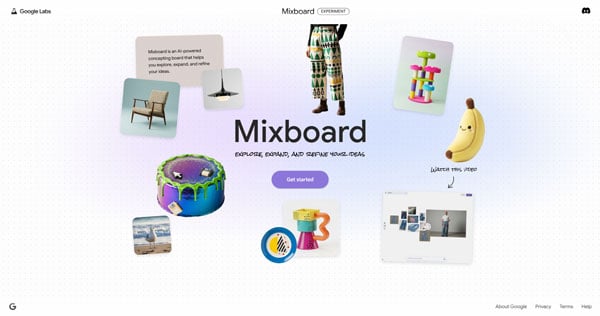
I used Mixboard to design a new mascot character for my website, “Minna no Raku Raku Magazine”.
1. Initial Idea Generation
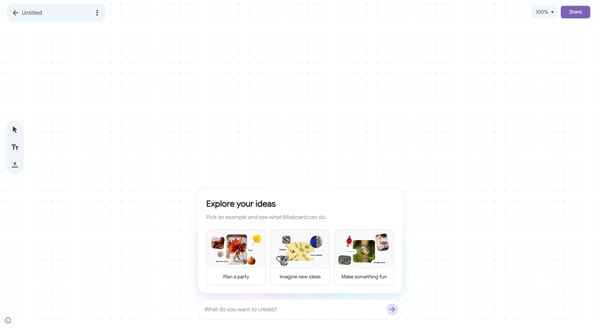
I navigated to the Mixboard site (labs.google.com/mixboard/projects) and selected “New project”. Although the interface is in English, I found that Japanese prompts worked without any problem. I inputted a general prompt: “Proposal for a new character suitable for a media dealing with AI, gadgets, communication, games, and beauty”. Mixboard immediately generated 15 character proposals and displayed them on the board. These images, referred to as blocks, could be freely moved and scaled.

2. Visual Mixing

From the initial 15 designs, I selected four that inspired me most and requested refinement. The prompt I used was: “Please mix the other characters well, centering on the character with headphones”. The result was a new, unified character image that cleverly combined elements from the four selected designs.
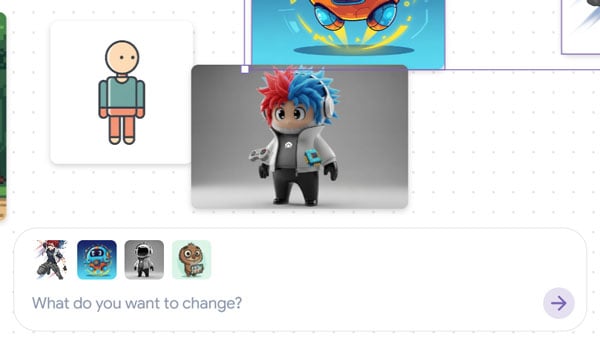
3. Adding Action and Variation
Next, I wanted to see the new character in action. After selecting the generated character, I instructed: “Please suggest a few images showing this character holding a controller and playing a game, or holding up a CPU, with some action”. Mixboard quickly delivered three “action variations,” showing scenes of the character engaged in activities like gaming.
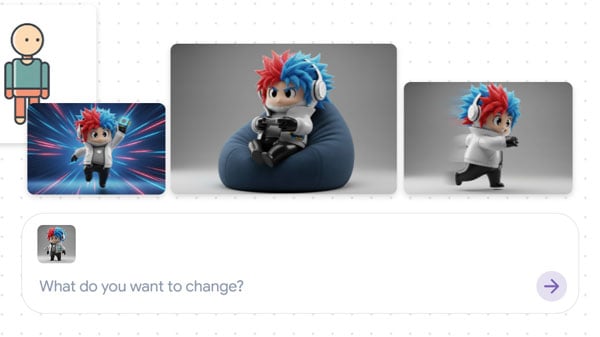
4. Co-starring with an Existing Character (Design Application)
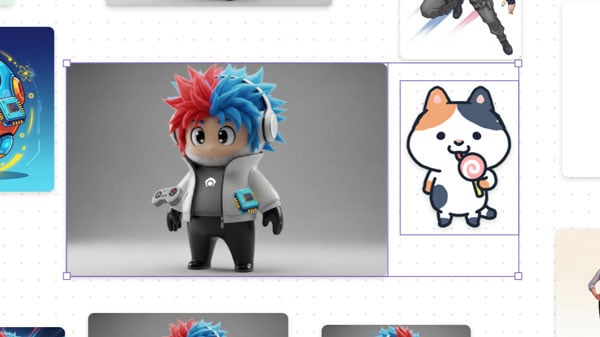
To further test the tool, I uploaded a previously created cat character from “Minna no Raku Raku Magazine” to the board using simple drag-and-drop. I selected both the newly created character and the cat character and prompted: “Create an image of the two characters happily co-starring”. A perfect co-starring image was generated, successfully concluding the concepting work on the board.
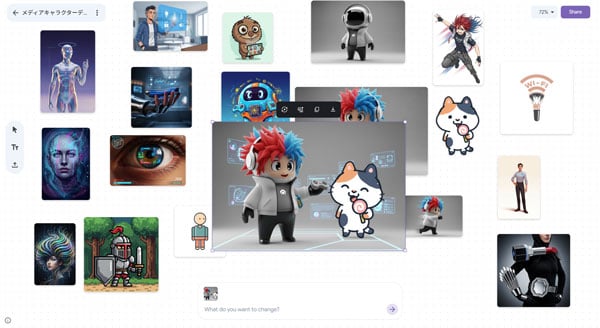
Honest Feedback: Mixboard’s Strengths and Areas for Improvement
【Mixboard’s Strengths!】
- Incredibly Fast Idea Materialization: Unlike the step-by-step image generation of Gemini or ChatGPT, Mixboard generates a large number of images—often up to 20—from a single prompt. This makes it highly efficient to quickly approach the desired design by comparing and refining multiple options.
- Flexible Idea Expansion: The ability to freely combine and “mix” images is a powerful feature unique among image generation tools. I felt this potential to create unexpected new designs that genuinely exceed my initial input was a huge benefit.
- Optimized for Design Review: While traditional AI image generation is adequate for one-off images, Mixboard serves as a powerful ally for the process of serious design exploration and iterative refinement.
- Intuitive Operation: The canvas operation is very user-friendly, feeling similar to using presentation software like PowerPoint or a design tool like Figma.
【Points to Watch Out For (Cons)】
- Consistency Challenges: When attempting to generate multiple variations of a character in a consistent style, subtle changes in facial features or styling can occur unless I explicitly directed the AI to maintain consistency.
- Detailed Editing Limitations: Features like changing the image aspect ratio (proportion) are not yet supported. Furthermore, specific text instructions for image replacement or synthesis occasionally did not produce the anticipated results.
- Rights and Licensing: If you plan on commercial use of Mixboard-generated images, it is crucial to confirm the copyright and usage scope in accordance with your internal guidelines. Be careful to avoid imitating existing copyrighted characters or works.
Mixboard truly stands out because it allows me to incorporate my own existing images and ideas (such as the cat character) and work collaboratively with the AI to refine them into a clearer, more definite form—a key difference from previous image generation tools.
> Click here for the official Google Mixboard page
Accelerating Design and Ideas: The Future Mixboard Brings
Google Mixboard functions not just as an image generation tool but as an “Ideation Engine”. For designers and planners, its capability to quickly convert vague mental concepts into concrete visual proposals has the power to fundamentally change workflows.
Accelerating Planning and Design Tasks
Mixboard is particularly effective for creating mood boards used to visually communicate concepts to clients or team members during the planning phase.
For example, an interior designer can input client requests (e.g., “bright natural light,” “oak furniture”). The AI generates multiple room concepts; the designer can then select preferred items (plants, lighting) and instruct the AI to synthesize them into a single, cohesive layout. This process significantly reduces the time and cost that would typically be required for photo shooting or commissioning external designers.
For content creators and marketers, Mixboard allows for the bulk generation of multiple A/B testing images for social media ads or blog thumbnails, all while ensuring a consistent visual tone. This efficiency directly translates to a reduction in production man-hours.
Expanding New Ideas and Creativity
The greatest value of Mixboard lies in how the AI supports the process of “materializing one’s own ideas and making them even better”.
Mixboard demonstrates context awareness, understanding the nuances of user prompts and existing images. It often suggests designs based on latent ideas or unexpected combinations that we may not have explicitly articulated, which significantly broadens the scope of our creative thinking.
The user experience feels like a true collaborative brainstorming session with AI. Instead of relying on the AI to do all the work, the user selects the most promising visuals from the many ideas generated, then combines and adjusts them manually.
Google Mixboard has the potential to become a new standard tool, enabling anyone—even those without extensive design skills or image editing knowledge—to explore and concretize their creative ideas effectively. I highly recommend trying the tool for free with your Google account to accelerate your design and documentation workflow.
> Click here for the official Google Mixboard page
Satoshi / Editor-in-Chief, Minna no RakuRaku Magazine
SEO & AI Specialist. Gadget, Game & Urban Legend enthusiast. Former musician (songwriter). Leveraging web marketing experience to write on the theme of “easy tech.” Also manages internal AI implementation.



